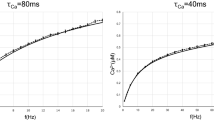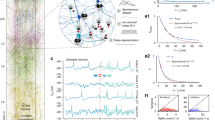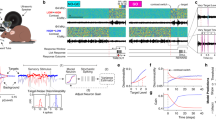Abstract
Spike-frequency adaptation (SFA) is widespread in the CNS, but its function remains unclear. In neocortical pyramidal neurons, adaptation manifests itself by an increase in the firing threshold and by adaptation currents triggered after each spike. Combining electrophysiological recordings in mice with modeling, we found that these adaptation processes lasted for more than 20 s and decayed over multiple timescales according to a power law. The power-law decay associated with adaptation mirrored and canceled the temporal correlations of input current received in vivo at the somata of layer 2/3 somatosensory pyramidal neurons. These findings suggest that, in the cortex, SFA causes temporal decorrelation of output spikes (temporal whitening), an energy-efficient coding procedure that, at high signal-to-noise ratio, improves the information transfer.
This is a preview of subscription content, access via your institution
Access options
Subscribe to this journal
Receive 12 print issues and online access
$209.00 per year
only $17.42 per issue
Buy this article
- Purchase on Springer Link
- Instant access to full article PDF
Prices may be subject to local taxes which are calculated during checkout





Similar content being viewed by others
References
Attwell, D. & Laughlin, S.B. An energy budget for signaling in the grey matter of the brain. J. Cereb. Blood Flow Metab. 21, 1133–1145 (2001).
Laughlin, S.B. Energy as a constraint on the coding and processing of sensory information. Curr. Opin. Neurobiol. 11, 475–480 (2001).
Barlow, H. Possible principles underlying the transformation of sensory messages. in Sensory Communication (ed. Rosenblith, W.A.) 217–234 (MIT Press, Cambridge, Massachusetts, 1961).
Srinivasan, M.V., Laughlin, S.B. & Dubs, A. Predictive coding: a fresh view of inhibition in the retina. Proc. R. Soc. Lond. B Biol. Sci. 216, 427–459 (1982).
Dong, D. & Atick, J. Temporal decorrelation: a theory of lagged and nonlagged responses in the lateral geniculate nucleus. Network 6, 159–178 (1995).
Dan, Y., Atick, J. & Reid, R.C. Efficient coding of natural scenes in the lateral geniculate nucleus: experimental test of a computational theory. J. Neurosci. 16, 3351–3362 (1996).
Pitkow, X. & Meister, M. Decorrelation and efficient coding by retinal ganglion cells. Nat. Neurosci. 15, 628–635 (2012).
Wark, B., Lundstrom, B.N. & Fairhall, A.L. Sensory adaptation. Curr. Opin. Neurobiol. 17, 423–429 (2007).
Wainwright, M.J. Visual adaptation as optimal information transmission. Vision Res. 39, 3960–3974 (1999).
Brenner, N., Bialek, W. & de Ruyter van Steveninck, R. Adaptive rescaling maximizes information transmission. Neuron 26, 695–702 (2000).
Fairhall, A.L., Lewen, G.D., Bialek, W. & de Ruyter Van Steveninck, R.R. Efficiency and ambiguity in an adaptive neural code. Nature 412, 787–792 (2001).
Maravall, M., Petersen, R.S., Fairhall, A.L., Arabzadeh, E. & Diamond, M.E. Shifts in coding properties and maintenance of information transmission during adaptation in barrel cortex. PLoS Biol. 5, e19 (2007).
Baccus, S.A. & Meister, M. Fast and slow contrast adaptation in retinal circuitry. Neuron 36, 909–919 (2002).
Ulanovsky, N., Las, L., Farkas, D. & Nelken, I. Multiple time scales of adaptation in auditory cortex neurons. J. Neurosci. 24, 10440–10453 (2004).
Simoncelli, E.P. & Olshausen, B. Natural image statistics and neural representation. Annu. Rev. Neurosci. 24, 1193–1216 (2001).
Izhikevich, E.M. Simple model of spiking neurons. IEEE Trans. Neural Netw. 14, 1569–1572 (2003).
Brette, R. & Gerstner, W. Adaptive exponential integrate-and-fire model as an effective description of neuronal activity. J. Neurophysiol. 94, 3637–3642 (2005).
Spain, W.J. & Schwindt, P. Two transient potassium currents in layer V pyramidal neurones from cat sensorimotor cortex. J. Physiol. (Lond.) 434, 591–607 (1991).
Gilboa, G., Chen, R. & Brenner, N. History-dependent multiple-timescale dynamics in a single-neuron model. J. Neurosci. 25, 6479–6489 (2005).
La Camera, G. et al. Multiple time scales of temporal response in pyramidal and fast spiking cortical neurons. J. Neurophysiol. 96, 3448–3464 (2006).
Lundstrom, B.N., Higgs, M.H., Spain, W.J. & Fairhall, A.L. Fractional differentiation by neocortical pyramidal neurons. Nat. Neurosci. 11, 1335–1342 (2008).
Drew, P.J. & Abbott, L.F. Models and properties of power-law adaptation in neural systems. J. Neurophysiol. 96, 826–833 (2006).
Fleidervish, I.A., Friedman, A. & Gutnick, M.J. Slow inactivation of Na+ current and slow cumulative spike adaptation in mouse and guinea-pig neocortical neurones in slices. J. Physiol. (Lond.) 493, 83–97 (1996).
Mickus, T., Jung, H.y. & Spruston, N. Properties of slow, cumulative sodium channel inactivation in rat hippocampal CA1 pyramidal neurons. Biophys. J. 76, 846–860 (1999).
Melnick, I.V., Santos, S.F.A. & Safronov, B.V. Mechanism of spike frequency adaptation in substantia gelatinosa neurones of rat. J. Physiol. (Lond.) 559, 383–395 (2004).
Madison, D.V. & Nicoll, R.A. Control of the repetitive discharge of rat CA 1 pyramidal neurones in vitro. J. Physiol. (Lond.) 354, 319–331 (1984).
Schwindt, P.C., Spain, W.J. & Crill, W.E. Long-lasting reduction of excitability by a sodium-dependent potassium current in cat neocortical neurons. J. Neurophysiol. 61, 233–244 (1989).
Sanchez-Vives, M.V., Nowak, L.G. & McCormick, D.A. Cellular mechanisms of long-lasting adaptation in visual cortical neurons in vitro. J. Neurosci. 20, 4286–4299 (2000).
Wang, X.J., Liu, Y., Sanchez-Vives, M.V. & McCormick, D.A. Adaptation and temporal decorrelation by single neurons in the primary visual cortex. J. Neurophysiol. 89, 3279–3293 (2003).
Rieke, F., Warland, D., de Ruyter van Steveninck, R. & Bialek, W. Spikes: Exploring the neural code (MIT Press, Cambridge, Massachusetts, 1999).
Crochet, S., Poulet, J.F.A., Kremer, Y. & Petersen, C.C.H. Synaptic mechanisms underlying sparse coding of active touch. Neuron 69, 1160–1175 (2011).
Gerstner, W. & Kistler, W. Spiking Neuron Models: Single Neurons, Populations, Plasticity (Cambridge University Press, New York, 2002).
Mensi, S. et al. Parameter extraction and classification of three cortical neuron types reveals two distinct adaptation mechanisms. J. Neurophysiol. 107, 1756–1775 (2012).
Jolivet, R. et al. The quantitative single-neuron modeling competition. Biol. Cybern. 99, 417–426 (2008).
Naud, R., Gerhard, F., Mensi, S. & Gerstner, W. Improved similarity measures for small sets of spike trains. Neural Comput. 23, 3016–3069 (2011).
Atick, J. Could information theory provide an ecological theory of sensory processing? Network 22, 4–44 (2011).
Benda, J. & Herz, A.V.M. A universal model for spike-frequency adaptation. Neural Comput. 15, 2523–2564 (2003).
Köndgen, H. et al. The dynamical response of neocortical neurons to temporally modulated noisy inputs in vitro. Cereb. Cortex 18, 2086–2097 (2008).
Toib, A., Lyakhov, V. & Marom, S. Interaction between duration of activity and time course of recovery from slow inactivation in mammalian brain Na+ channels. J. Neurosci. 18, 1893–1903 (1998).
Lowen, S.B., Liebovitch, L.S. & White, J.A. Fractal ion-channel behavior generates fractal firing patterns in neuronal models. Phys. Rev. E Stat. Phys. Plasmas Fluids Relat. Interdiscip. Topics 59, 5970–5980 (1999).
Bohte, S.M. & Rombouts, J.O. Fractionally predictive spiking neurons. Neural Inf. Process. Syst. 23, 253–261 (2010).
Mar, D.J., Chow, C.C., Gerstner, W., Adams, R.W. & Collins, J.J. Noise shaping in populations of coupled model neurons. Proc. Natl. Acad. Sci. USA 96, 10450–10455 (1999).
Shin, J. Adaptation in spiking neurons based on the noise shaping neural coding hypothesis. Neural Netw. 14, 907–919 (2001).
Chacron, M.J., Lindner, B. & Longtin, A. Noise shaping by interval correlations increases information transfer. Phys. Rev. Lett. 92, 080601 (2004).
Avila-Akerberg, O. & Chacron, M.J. Nonrenewal spike train statistics: causes and functional consequences on neural coding. Exp. Brain Res. 210, 353–371 (2011).
Lefort, S., Tomm, C., Sarria, J.C.F. & Petersen, C.C.H. The excitatory neuronal network of the C2 barrel column in mouse primary somatosensory cortex. Neuron 61, 301–316 (2009).
Avermann, M., Tomm, C., Mateo, C., Gerstner, W. & Petersen, C.C.H. Microcircuits of excitatory and inhibitory neurons in layer 2/3 of mouse barrel cortex. J. Neurophysiol. 107, 3116–3134 (2012).
Jolivet, R., Rauch, A., Lüscher, H. & Gerstner, W. Predicting spike timing of neocortical pyramidal neurons by simple threshold models. J. Comput. Neurosci. 21, 35–49 (2006).
Truccolo, W., Eden, U.T., Fellows, M.R., Donoghue, J.P. & Brown, E.N. A point process framework for relating neural spiking activity to spiking history, neural ensemble and extrinsic covariate effects. J. Neurophysiol. 93, 1074–1089 (2005).
Pillow, J.W. et al. Spatio-temporal correlations and visual signaling in a complete neuronal population. Nature 454, 995–999 (2008).
Brette, R. et al. High-resolution intracellular recordings using a real-time computational model of the electrode. Neuron 59, 379–391 (2008).
Badel, L. et al. Dynamic I-V curves are reliable predictors of naturalistic pyramidal-neuron voltage traces. J. Neurophysiol. 99, 656–666 (2008).
Paninski, L., Pillow, J. & Simoncelli, E. Comparing integrate-and-fire models estimated using intracellular and extracellular data. Neurocomputing 65, 379–385 (2005).
Brillinger, D.R. Maximum likelihood analysis of spike trains of interacting nerve cells. Biol. Cybern. 59, 189–200 (1988).
Paninski, L. Maximum likelihood estimation of cascade point-process neural encoding models. Network 15, 243–262 (2004).
Acknowledgements
We thank C.C.H. Petersen, B.N. Lundstrom, G. Hennequin and A. Seeholzer for helpful discussions. We are also grateful to S. Crochet for sharing in vivo recordings and to B.N. Lundstrom for sharing the data that inspired this work. Finally, we thank S. Naskar for his help with the in vitro recordings. This project was funded by the Swiss National Science Foundation (grant no. 200020 132871/1; C.P. and S.M.) and by the European Community's Seventh Framework Program (BrainScaleS, grant no. 269921; S.M. and R.N.).
Author information
Authors and Affiliations
Contributions
C.P. and R.N. conceived the study. C.P. designed the experiments, analyzed the data, performed the modeling and wrote the initial draft of the manuscript. S.M. contributed to data analysis and modeling. W.G. supervised the project. All of the authors worked on the manuscript.
Corresponding author
Ethics declarations
Competing interests
The authors declare no competing financial interests.
Supplementary information
Supplementary Text and Figures
Supplementary Figures 1–8, Supplementary Table 1, Supplementary Data Preprocessing and Supplementary Modeling (PDF 1911 kb)
Rights and permissions
About this article
Cite this article
Pozzorini, C., Naud, R., Mensi, S. et al. Temporal whitening by power-law adaptation in neocortical neurons. Nat Neurosci 16, 942–948 (2013). https://doi.org/10.1038/nn.3431
Received:
Accepted:
Published:
Issue Date:
DOI: https://doi.org/10.1038/nn.3431
This article is cited by
-
Fractional order memcapacitive neuromorphic elements reproduce and predict neuronal function
Scientific Reports (2024)
-
Dendritic excitability controls overdispersion
Nature Computational Science (2023)
-
Cycles in asymptotically stable and chaotic fractional maps
Nonlinear Dynamics (2021)
-
A solution to the learning dilemma for recurrent networks of spiking neurons
Nature Communications (2020)
-
Somatodendritic consistency check for temporal feature segmentation
Nature Communications (2020)



